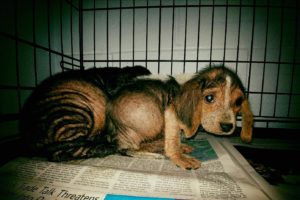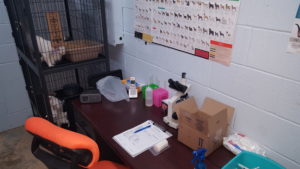An Insider’s Look at Animal Rescue – Intake (part 2)

After arriving at the shelter, the two puppies were immediately taken into the assessment room where our vet tech performed an intake evaluation. This is a series of tests and observation that determine their first priority needs and identifies any possible communicable diseases they may have. Intake typically takes from twenty minutes to an hour.
Of immediate concern to the vet tech was their loss of hair and their swollen bellies. The hair loss could be caused by many things, but stress, flea allergies, exposure, or infection are among the most common causes. Determining which of these it is becomes a process of elimination. In cases where it is suspected that they have a contagious condition such as sarrcoptic mange, a skin scraping is performed and the samples examined under a microscope to look for the mites that cause it. Under high magnification, these tiny organisms appear round with small extensions in the front.
Seeing these in a skin scraping sample shows that the dog has sacoptic mange and should be kept in isolation away from other animals until it is fully treated.

A second type of mange, Demodectic Mange, is also caused by mites, but is not considered contagious. All dogs have these mites living on them, so transferring them from one dog to another does not “infect” them. Unlike Sarcoptic mange, symptoms of this type of mange are an immune reaction to the mites which is more like an allergy than an infection. If a dog is found to have Demodectic mange, it is not necessary to isolate it from other dogs, but it still requires treatment to alleviate the symptoms. In serious cases, there is a high risk of skin infection since the skin breaks out in rashes and the animal scratches large areas of skin raw.
The skin scrapings confirmed what the vet tech already suspected. They had Demodectic mange. They would need to start treatments immediately, beginning with a bath in a mite-killing liquid.
While this intake exam is being performed, back in the office, one of the staff members is creating a new animal record for each of them in the shelter management software. From this point on, any treatments, vaccinations, movements from one location to another, etc. will be entered into the system and a complete history will be created for the animals. One of the requirements for entry into the system is that all animals must have names, so it is up to the staff to name them. This may seem like a trivial task but when you sometimes take in up to a hundred animals per month, this can become challenging. These two little pups received the names Jackson and Sassy (“because she IS sassy!” says Jessica, the shelter director). They also had their pictures taken after they were all cleaned up.
The intake assessment for Jackson and Sassy didn’t find anything contagious or life threatening, which isn’t always the case. Sometimes an animal arrives lethargic and barely breathing or bleeding, limping, or with serious infections. In these cases, they are taken to one of the local vets for additional treatment and care. Fortunately there is no need for that with these puppies. Once the assessment is complete, they go through a routine battery of vaccinations, wormer, flea treatment, ear cleaning, and bathing. If they have skin problems, they are treated with a dip that kills the mites that cause it.
Within an hour of arriving, these two puppies who came in without a hope left have been vaccinated, wormed, bathed, fed and photographed. At this point, they are usually exhausted and with a full tummy, glad to get some time to lie down on a soft bed and sleep. They still don’t know what has happened to them, where they are, or who these people are, but they are safe, fed, and cared for which, in many cases, is completely new to them. They have made it through the door and have begun the road back to a healthy and happy life, but there is a long way to go.
 |
 |
|
| Jackson | Sassy |

